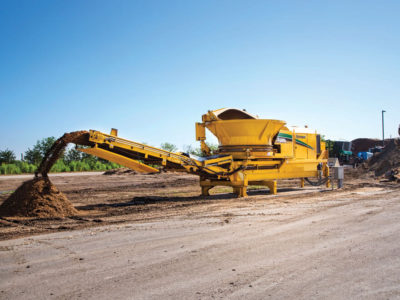The world is rapidly turning to more electric sources of energy, and the world of wood waste is no exception. Just as more electric cars are on the roadways, electric grinders, like the Vermeer HG4000E horizontal grinder, HG6000E horizontal grinder, TG5000E tub grinder and TG7000E tub grinder, are advancing the wood waste workforce.
The turn to electric has many compounding factors, including the growing number of eco initiatives and regulations regarding fossil fuels. With so many regulations, some business owners are turning to electric grinders for their operations. Beyond that, the lack of oil changes and clutch on the electric machines create enticing arguments to make the switch.
Benefits of electric grinder motors
Going electric certainly has benefits — no exhaust emissions, minimized noise pollution and efficient performance make electric horizontal grinders and electric tub grinders a great option for your business.
Being powered by electricity means no engine exhaust emissions, which creates more options for grinder placement on the jobsite.
Electric engines also make minimal noise while running, which minimizes the disturbance to those working and living around your jobsite.
And don’t worry; to gain these benefits, you don’t trade away performance. The horsepower of the motors in Vermeer electric grinders is similar to those in Vermeer diesel grinders. The difference is the setup of each motor — diesel engines require chain reactions whereas electric motors have the power constantly on demand.
“There is a noticeable difference in electric motor reactivity,” said Ted Dirkx, Vermeer sales manager for recycling and forestry.
Considerations for going electric
Investing in electric can mean rearranging your jobsite. In order to keep the motor working, the grinder must be hooked up to the electric power source. This makes it stationary, creating a unique opportunity to design an efficient flow of material.
Constant connection to power for it to operate also means you need a consistent power supply. Being hooked up to a starter panel is required to convert electricity to usable power for the grinder’s motor. There are two options for this: variable frequency drive (VFD) or soft starts. VFD regulates power surges leading to a more responsive motor, whereas the soft start power is essentially uncontrolled which can cause amperage spikes leading to inefficiency.
“At Vermeer, we recommend the VFD to achieve maximum performance and a desirable experience,” said Dirkx.
This also means the right infrastructure needs to be in place at your jobsite.
“If you are considering an electric grinder, it is important to work closely with your local power supplier or company to understand what you have and what’s going to be needed,” said Dirkx.
Being in contact with the power company will also help you understand the long-term costs associated with supplying power to the grinder.
“We also recommend working with a local electrician,” said Dirkx. “You’ll need to connect with an electrician who knows the local electrical code.”
Electric grinders aren’t for everyone — sometimes it makes more sense for your business to stick with diesel. Whatever you decide, there is Vermeer equipment to meet both needs. To learn more about horizonal and tub grinders, contact your local dealer.
Vermeer Corporation reserves the right to make changes in product engineering, design and specifications; add improvements; or discontinue manufacturing or distribution at any time without notice or obligation. Equipment shown is for illustrative purposes only and may display optional accessories or components specific to their global region. Please contact your local Vermeer dealer for more information on machine specifications.
Vermeer and the Vermeer logo are trademarks of Vermeer Manufacturing Company in the U.S. and/or other countries. © 2022 Vermeer Corporation. All Rights Reserved.
